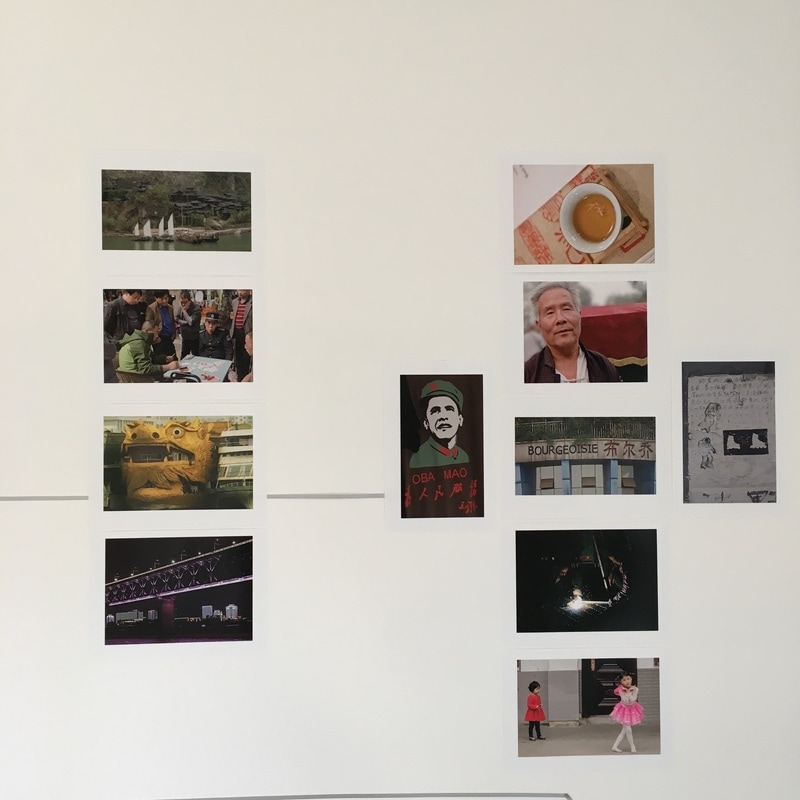Anchor 4
Map Office, ‘Play Under’ from ‘Underneath’
Included in the exhibition Arterial Motives – 2014
Underneath by Hong Kong-based MAP Office (Laurent Gutierrez and Valérie Portefaix) is a stunning documentation of life under a 63-kilometer raised highway loop surrounding the Chinese city of Guangzhou. This sprawling city-inside-the city forcefully imposes its haphazard logic onto the urban landscape, creating surreal propositions for land use in our emerging global metropolises.
|
|
Responses:
4A. Thomas Soden's 'On the Sunset Strip'
4B. Peter West, Photography
For most of my life, China existed as a vague and nebulous “idea” of a place. On the other side of the globe and in the back of my mind. Literally from childhood, the secondhand images were at the same fascinating and vaguely menacing, even, at times, ridiculous: “Dig a deep enough hole in the backyard and you’ll end up in China.” The cartoonish images, from Mulan to Dr. Fu Manchu. TV commercials from my youth: “La Choi makes Chinese food, swing, American. The peasants, seen through the eyes of a Western writer, in The Good Earth. The decadent end of Imperial China as portrayed in The Last Emperor. The 1960s atrocities of the Red Guards and, lately, in the headlines about a nascent superpower arising in the East to challenge my own country for global supremacy. I was fortunate to take a cruise up the Yangtze last fall from Shanghai to Chongqing and from there to Xian and Beijing, I saw a fraction of a massive country that most Westerners never have seen, and never will. It was an experience impossible to fully capture in a handful of photographs. Beautiful, yet heavily polluted. Modern, as in Shanghai, and timeless, as, increasingly fewer parts of Beijing. An ancient country grappling, more or less successfully to compete in the modern world. Where a restaurant named Bourgeoisie surely would have The Great Helmsman of the Cultural Revolution spinning is his grave. A nation that is open enough to allow Westerners to visit rural hamlets not very far removed from the pre-revolutionary days of feudalism. Existing, for now, in the same nation as modern financial centers like Hong Kong and Shanghai. But which of those two realities represent China’s future? Or is it both? Can it be both? A nation willing to open doors to the West, yet where tour guides will admit that most people are aware of the image of a man standing down tanks in Tiananmen Square, yet the image itself remains officially banned and then deftly change the subject. A nation proud of its engineering achievements, such as the Three Gorges Dam, but not so concerned that millions of people without an official voice were relocated from their ancestral homes to newly built cities to make them possible. Where a stroll down the street in Xian takes you to the beautiful city wall, a tangible link to China’s past. And a stroll back takes you through an antiques market, where mummified tiger paws and other pieces of endangered species are for sale in plain view. It was an opportunity I wouldn’t have missed for anything. I know about the ‘real” China as opposed to fantasy land I’d conjured as a younger man. Do I understand it more? I am doubtful. 4C. Felise Luchansky – Wish You Were Here -The Boardwalk Walk
“The boardwalk was where all of New Jersey came together. Where New Jersey for better of worse met itself”. Junot Diaz In the spring and summer of 2011, prior to Hurricane Sandy, I set out to walk the entire length of the boardwalks in New Jersey. I walked an average of 7 miles per day to complete approximately the 26 miles of wooden and concrete ribbon alongside the Atlanic Ocean. This project is a document of that journey. Additionally, as an archivist artist, I have collected postcards for over 30 years. Many of them depict the Jersey boardwalks. The boardwalk has a long collective history as a tourist destination. People vacationed down the shore. For over a hundred years, visitors documented their visits by sending postcards back home. Postcards served as a testament to being at a specific place at a specific time. The postcard archive became source material to connect the past to the present in this project. As I walked each town’s boardwalk I discovered that each boardwalk had a distinct identity. Some boardwalks were residential. Others were linear junk food courts. Most embraced commerce and championed amusement. I could see, hear, smell and taste the strong sense of place. As I walked from one town to the next there were memorials to lost loved ones inscribed on benches facing the ocean and monuments memorializing those from New Jersey who were lost on 9/11. In Ocean Grove, the vestiges of a religious past were present as the honkytonk vibe of Asbury Park abruptly ended and was replaced with signs listing the blue laws that defined Sunday behavior. The elegant saltwater pools, adorned with mosaics, graced the boardwalk in exclusive Spring Lake, informing all who passed that the pools were for “residents only.” Point Pleasant welcomed all (for a fee) to use the bathhouses, rent cabanas and try their luck at the clanging arcade. All were unique destinations yet all had one thing in common- the sand and the ocean were steps away. List of boardwalks in New Jersey from North to South Keansburg Seaside Heights Sea Bright Seaside Park Long Branch Atlantic City Asbury Park Ventnor Ocean Grove Ocean City Bradley Beach Sea Isle City Avon by the Sea The Wildwoods Belmar Cape May Spring Lake Sea Girt Manasquan Point Pleasant Lavallette Felise Luchansky This project is a document of that journey. |



